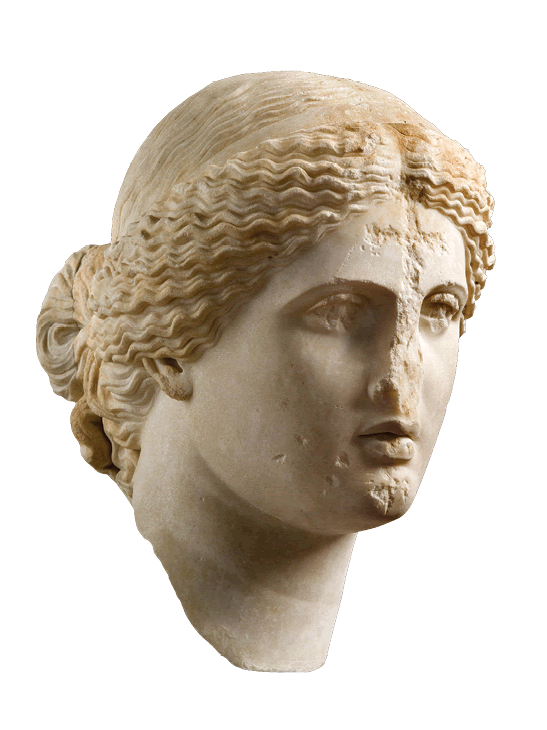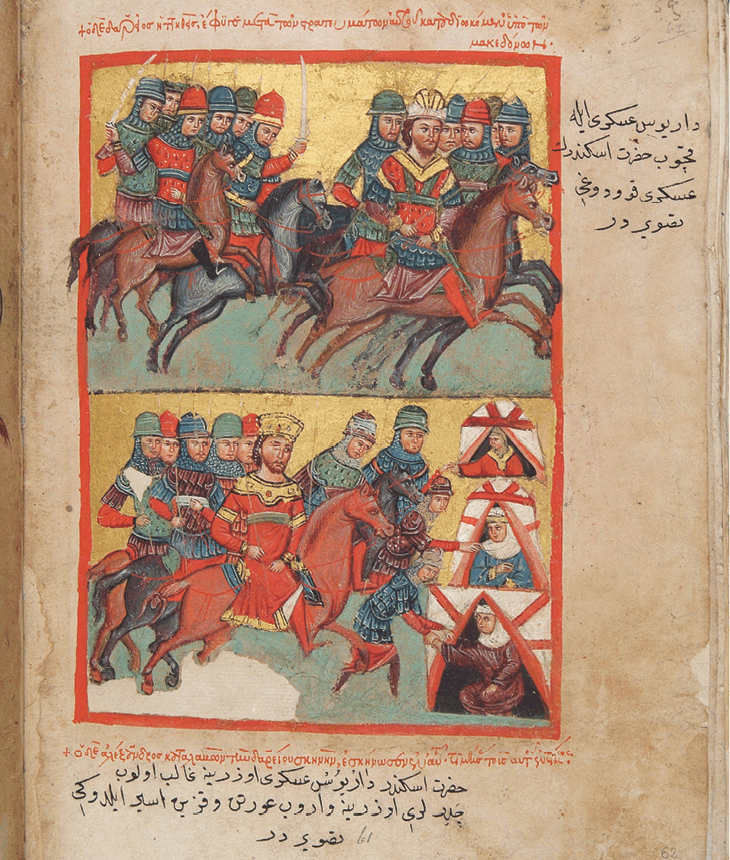News
Layers of Culture: Byzantine Artifacts in Heaven and Earth
 Why would a Christian carve a cross on the forehead of a sculpture of Aphrodite? Why would a Muslim ruler ask that Turkish captions be written in the Greek illustrated manuscript about Alexander the Great’s life? And how did a pirate’s treasures, including earrings decorated with Arabic names, ultimately end up in Greece? These are only some of the questions that might arise in the mind of a visitor to the exhibit Heaven and Earth: Byzantine Illumination at the Cultural Crossroads at the Getty Villa in Los Angeles through August 25, 2014. Byzantine treasures such as the icon of the Virgin Hodegetria have been loaned by the Greek government to US museums in 2013, and were first on display in the National Gallery of Art in Washington, DC. After leaving the Getty, they will be on display at the Art Institute of Chicago in the fall.
Why would a Christian carve a cross on the forehead of a sculpture of Aphrodite? Why would a Muslim ruler ask that Turkish captions be written in the Greek illustrated manuscript about Alexander the Great’s life? And how did a pirate’s treasures, including earrings decorated with Arabic names, ultimately end up in Greece? These are only some of the questions that might arise in the mind of a visitor to the exhibit Heaven and Earth: Byzantine Illumination at the Cultural Crossroads at the Getty Villa in Los Angeles through August 25, 2014. Byzantine treasures such as the icon of the Virgin Hodegetria have been loaned by the Greek government to US museums in 2013, and were first on display in the National Gallery of Art in Washington, DC. After leaving the Getty, they will be on display at the Art Institute of Chicago in the fall.
The exhibit contains sculptures, icons, manuscripts, and artifacts made between the first century CE and the second half of the 15th century. They point to the great diversity of the Byzantine Empire, the cultural exchanges between pagan Greeks, Eastern and Western Christians, and Muslims. Glenn Peers, professor of early medieval and Byzantine art at the University of Texas at Austin, said in an interview that Byzantine embassies went out to the Muslim world, contributing to Byzantine encounters with Muslim culture. He added that students from Constantinople traveled to Persia and Iraq to further their education.
The head of Aphrodite, which was probably made in the first century, was maimed by a Christian who carved a cross on its forehead and damaged its eyes. The Christian destruction of Greek sculptures began in Late Antiquity, when the statue of the cult of Cronus was broken into pieces, then reused to build a cross, and the pagan temple known as the Serapeum was destroyed with its idols in Alexandria.1 In the third and fourth centuries CE, crosses were carved on the heads of other sculptures in Alexandria and on the breastplate armor of a statue of Marcus Aurelius. A sixth-century biography of Severus, the patriarch of Antioch, describes the “trial” and burning of Greek statues. At this event, idols were exhibited and the pagan priest of the Temple of Isis was questioned about their use. Historians such as Troels Myrup Kristensen suggest that the carving of the cross on a statue might serve as a “ritual act of baptism or as a means of accepting the pagan image into a Christian life.”2 In essence, then, the blinded Aphrodite was saved from destruction by the cross that was carved on her forehead.
The exhibit brings into question the idea that Christian and non-Christian cultures were isolated in the Byzantine period between 330 and 1453. Centuries before the age of globalization, Muslims and Christians were exchanging aesthetic sensibilities and borrowing narratives and ornaments from each other, with influences going both ways.
An example of the blending of cultures is a closure panel separating the altar area from the main area of a church. Made in Corinth around the year 1000, this panel is decorated with meaningless inscriptions that imitate Arabic script. Art historian Aneta Georgievska-Shine said in a phone interview that the trend of using pseudo-Arabic scripts to decorate Christian art continued into the Renaissance era. Paintings of the Virgin Mary portrayed her enthroned, with a carpet decorated by such inscriptions beneath her feet. In other paintings the trim of her veil is decorated with pseudo-Kufic inscriptions. In some cases, these allusions were intended to emphasize that Islam was conquered or at the margins of the Byzantine Empire, while in other cases they were acts of appreciative borrowing.
Christianity itself was not a single culture. There were major differences in theology and practice between Eastern and Western Christianity in the Byzantine period. Andreas Pavias’s Icon of the Crucifixion combines Eastern and Western Christian elements and “a whole history of Christian doctrine,” Susan Ashbrook Harvey, professor of religious studies at Brown University, said in a phone interview. The icon’s depiction of faces is typical of Eastern icons; those who are abusing Jesus are not portrayed with ugly, distorted faces, as they are often depicted in Western Christian art from the same period. But the icon contains some Western elements as well, such as the portrayal of Mary Magdalene in red, with her hair unbound, holding the cross and weeping. In Eastern Orthodox portrayals, Mary Magdalene would normally not be portrayed as a prostitute, and she would appear with the women surrounding the Virgin Mary.
At the time it was made, this icon, like other icons from the Byzantine period, would not have been seen as an aesthetic object to be admired but never touched. The exhibit does not portray to the visitor how much the items on display were used—touched, kissed, and otherwise utilized in everyday life, whether secular or religious. Peers mentioned that museum guards at Byzantine exhibits are especially vigilant because devout visitors often try to kiss the icons. These icons were meant to be interacted with in that way, but their placement in exhibits, and their status as valuable historic objects, is what museum visitors often see instead.
Peers, who stresses the importance of the body in Eastern Christian theology and outlook, curated the exhibit Byzantine Things in the World at the Menil Collection in Houston. His goal was to change perceptions of these objects by pairing Byzantine pieces with artifacts from African and American cultures and changing other viewing conditions. Peers is now thinking about his next exhibit of Byzantine art, one that will focus on the arts of Trebizond, and he is currently searching for a venue to host it.
Shatha Almutawa is associate editor of Perspectives on History.
A close examination of Andreas Pavias’s Icon of the Crucifixion appearred on our blog, AHA Today here. Join the discussion about this and other icons on AHA Communities’ Byzantine History forum (communities.historians.org).
Notes
1. Troels Myrup Kristensen, “Religious Conflict in Late Antique Alexandria: Christian Responses to ‘Pagan’ Statues in the Fourth and Fifth Centuries CE,” in Alexandria: A Cultural and Religious Melting Pot (Aarhus, Denmark: Aarhus University Press, 2009), 158–75.
2. Kristensen, 167.

This work is licensed under a Creative Commons Attribution-NonCommercial-NoDerivatives 4.0 International License. Attribution must provide author name, article title, Perspectives on History, date of publication, and a link to this page.
The American Historical Association welcomes comments in the discussion area below, at AHA Communities, and in letters to the editor. Please read our commenting and letters policy before submitting.
Tags: History News Middle East Cultural History
Comment
Please read our commenting and letters policy before submitting.






